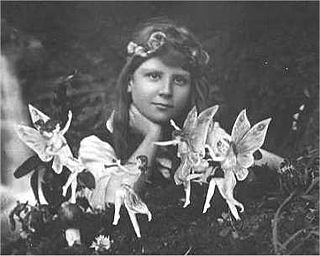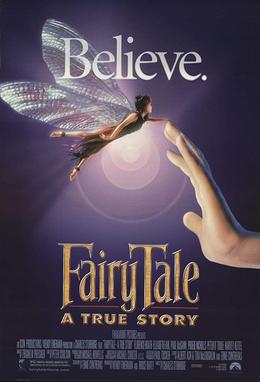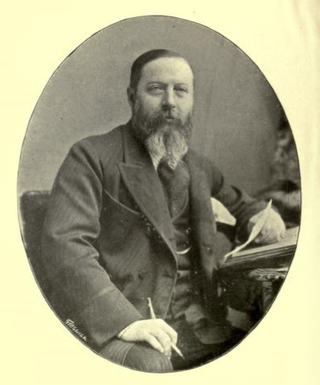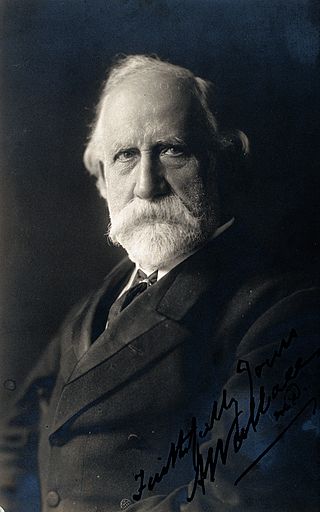Related Research Articles

The Cottingley Fairies appear in a series of five photographs taken by Elsie Wright (1901–1988) and Frances Griffiths (1907–1986), two young cousins who lived in Cottingley, near Bradford in England. In 1917, when the first two photographs were taken, Elsie was 16 years old and Frances was 9. The pictures came to the attention of writer Sir Arthur Conan Doyle, who used them to illustrate an article on fairies he had been commissioned to write for the Christmas 1920 edition of The Strand Magazine. Doyle, as a spiritualist, was enthusiastic about the photographs, and interpreted them as clear and visible evidence of psychic phenomena. Public reaction was mixed; some accepted the images as genuine, others believed that they had been faked.

The Society for Psychical Research (SPR) is a nonprofit organisation in the United Kingdom. Its stated purpose is to understand events and abilities commonly described as psychic or paranormal. It describes itself as the "first society to conduct organised scholarly research into human experiences that challenge contemporary scientific models." It does not, however, since its inception in 1882, hold any corporate opinions: SPR members assert a variety of beliefs with regard to the nature of the phenomena studied.

A leprechaun is a diminutive supernatural being in Irish folklore, classed by some as a type of solitary fairy. They are usually depicted as little bearded men, wearing a coat and hat, who partake in mischief. In later times, they have been depicted as shoe-makers who have a hidden pot of gold at the end of the rainbow.

Spiritualism is a social religious movement popular in the nineteenth and early twentieth centuries, according to which an individual's awareness persists after death and may be contacted by the living. The afterlife, or the "spirit world", is seen by spiritualists not as a static place, but as one in which spirits continue to interact and evolve. These two beliefs—that contact with spirits is possible, and that spirits are more advanced than humans—lead spiritualists to the belief that spirits are capable of advising the living on moral and ethical issues and the nature of God. Some spiritualists follow "spirit guides"—specific spirits relied upon for spiritual direction.

A séance or seance is an attempt to communicate with spirits. The word séance comes from the French word for "session", from the Old French seoir, "to sit". In French, the word's meaning is quite general and mundane: one may, for example, speak of "une séance de cinéma". In English, however, the word came to be used specifically for a meeting of people who are gathered to receive messages from ghosts or to listen to a spirit medium discourse with or relay messages from spirits. In modern English usage, participants need not be seated while engaged in a séance.
Irish folklore refers to the folktales, balladry, music, dance and mythology of Ireland. It is the study and appreciation of how people lived.

Frank Podmore was an English author and founding member of the Fabian Society as well as an influential member of the Society for Psychical Research. He is known for his interest in spiritualism, which he eventually developed a sceptical attitude towards, specifically the claims of mediumship which he attacked in his history of mediumship, The New Spiritualism (1910). However, he defended other spiritualist beliefs such as telepathy and ghosts.

Mediumship is the practice of purportedly mediating communication between familiar spirits or spirits of the dead and living human beings. Practitioners are known as "mediums" or "spirit mediums". There are different types of mediumship or spirit channelling, including séance tables, trance, and ouija. The practice is associated with spiritualism and spiritism. A similar New Age practice is known as channeling.

FairyTale: A True Story is a 1997 fantasy drama film directed by Charles Sturridge and produced by Bruce Davey and Wendy Finerman. It is loosely based on the story of the Cottingley Fairies, and follows two children in 1917 England who take a photograph soon believed to be the first scientific evidence of the existence of fairies. The film was produced by Icon Productions.
Iona Margaret Balfour Opie, and Peter Mason Opie were an English married team of folklorists who applied modern techniques to understanding children's literature and play, in studies such as The Oxford Dictionary of Nursery Rhymes (1951) and The Lore and Language of Schoolchildren (1959). They were also noted anthologists, assembled large collections of children's literature, toys, and games and were regarded as world-famous authorities on children's lore and customs.

William Hope was a pioneer of so-called "spirit photography". Based in Crewe, England, he was a member of the well known spiritualists group, the Crewe Circle. He died in Salford hospital on 8 March 1933.

William Stainton Moses was an English cleric and spiritualist medium. He promoted spirit photography and automatic writing, and co-founded what became the College of Psychic Studies. He resisted scientific examination of his claims, which have generally been demolished.

Sir Arthur Ignatius Conan Doyle was a British writer and physician. He created the character Sherlock Holmes in 1887 for A Study in Scarlet, the first of four novels and fifty-six short stories about Holmes and Dr. Watson. The Sherlock Holmes stories are milestones in the field of crime fiction.

In folklore and literature, the Fairy Queen or Queen of the Fairies is a female ruler of the fairies, sometimes but not always paired with a king. Depending on the work, she may be named or unnamed; Titania and Mab are two frequently used names. Numerous characters, goddesses or folkloric spirits worldwide have been labeled as Fairy Queens.

Trevor Henry Hall (1910–1991) was a British author, surveyor, and sceptic of paranormal phenomena. Hall made controversial claims regarding early members of the Society for Psychical Research. His books caused a heated controversy within the parapsychology community.

The Society for the Study of Supernormal Pictures (SSSP) was a short-lived psychical organization that formed in 1918 to investigate claims of spirit photography. It was established as a rival to the Society for Psychical Research.
Violet Alford was an internationally recognised authority on folk dancing and its related music, costume, and folk customs. She believed that a common prehistoric root explained the similarities found across much of Europe.
Walter Leo Hildburgh (1876-1955) was an American art collector, sportsman, traveller, scientist and philanthropist.
Patricia Lysaght is an Irish folklorist. She is Professor Emerita of European Ethnology, University College Dublin, Ireland.
Thomas Fairman Ordish (1855-1924), sometimes also referred to as T. Fairman Ordish was a British folklorist, noted for his interest in traditional drama and folk play, early theatre and the history of London. He is credited as having undertaken "the first major investigation of British traditional drama".
References
- 1 2 Anomalist Publishing 2014
- 1 2 "Magical Societies". Ithell Colquhoun. Archived from the original on 2008-05-09. Retrieved 2009-03-20.
- ↑ Nelson, Geoffrey K. (1969). "The Spiritualist Movement and the Need for a Redefinition of Cult". Journal for the Scientific Study of Religion. 8 (1): 152–160. doi:10.2307/1385263. JSTOR 1385263.
- ↑ Francesca, Bihet (March 2013). "Sprites, spiritualists and sleuths: the intersecting ownership of transcendent proofs in the Cottingley Fairy Fraud". eprints.chi.ac.uk. Retrieved 2018-10-19.
- 1 2 3 4 5 6 Young, Simon (August 2013). "A History of the Fairy Investigation Society, 1927–1960". Folklore. 124 (2): 139–156. doi:10.1080/0015587x.2013.788824. ISSN 0015-587X. S2CID 161811633.
- ↑ Russell, Ian (2006-01-01). "Leslie Alan Shepard (1917-2004): Page 5". Folk Music Journal. Retrieved 2009-03-20.
- 1 2 "Fairy Investigation Society". Radio National, The History Listen program (Podcast). Australian Broadcasting Corporation. 23 January 2018. Retrieved 23 January 2018.
- ↑ Riley, Tom (23 October 1960). "So That's How Fairies are Born". Sunday Pictorial. p. 3.
- 1 2 Wood, Juliette (2015-09-02). "Seeing Fairies: From the Lost Archives of the Fairy Investigation Society, Authentic Reports of Fairies in Modern Times". Folklore. 126 (3): 357–359. doi:10.1080/0015587x.2015.1051337. ISSN 0015-587X. S2CID 164035798.
- ↑ Evans-Wentz, W. Y. (December 2003). The Fairy Faith in Celtic Countries: The Classic Study of Leprechauns, Pixies, and Other Fairy Spirits. Citadel Press. ISBN 9780806525792.
- 1 2 Carey, Patrick (2018-02-08). "The rise, fall and rebirth of the Fairy Investigation Society". ABC News. Retrieved 2024-12-12.
- ↑ Balbi, C. M. R. (1961). Electrical engineering in the Royal Navy. Journal of the Institution of Electrical Engineers, 7(76), 225-226.
- ↑ Young, Simon (2023). "Walt and the Fairies". Fairy Films: Wee Folk on the Big Screen. Educated Dragon. pp. 213–229. ISBN 9781960644046.
- ↑ "'It's a wonderful world of love, laughter, and leprechauns'". UCD LIBRARY CULTURAL HERITAGE COLLECTIONS. 2017-06-14. Retrieved 2018-10-19.